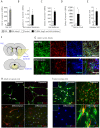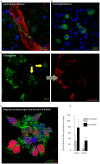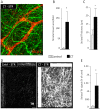Angiogenic factors stimulate growth of adult neural stem cells
- PMID: 20195471
- PMCID: PMC2829079
- DOI: 10.1371/journal.pone.0009414
Angiogenic factors stimulate growth of adult neural stem cells
Abstract
Background: The ability to grow a uniform cell type from the adult central nervous system (CNS) is valuable for developing cell therapies and new strategies for drug discovery. The adult mammalian brain is a source of neural stem cells (NSC) found in both neurogenic and non-neurogenic zones but difficulties in culturing these hinders their use as research tools.
Methodology/principal findings: Here we show that NSCs can be efficiently grown in adherent cell cultures when angiogenic signals are included in the medium. These signals include both anti-angiogenic factors (the soluble form of the Notch receptor ligand, Dll4) and pro-angiogenic factors (the Tie-2 receptor ligand, Angiopoietin 2). These treatments support the self renewal state of cultured NSCs and expression of the transcription factor Hes3, which also identifies the cancer stem cell population in human tumors. In an organotypic slice model, angiogenic factors maintain vascular structure and increase the density of dopamine neuron processes.
Conclusions/significance: We demonstrate new properties of adult NSCs and a method to generate efficient adult NSC cultures from various central nervous system areas. These findings will help establish cellular models relevant to cancer and regeneration.
Conflict of interest statement
Figures



Similar articles
-
A defined, controlled culture system for primary bovine chromaffin progenitors reveals novel biomarkers and modulators.Stem Cells Transl Med. 2014 Jul;3(7):801-8. doi: 10.5966/sctm.2013-0211. Epub 2014 May 22. Stem Cells Transl Med. 2014. PMID: 24855275 Free PMC article.
-
Cholera toxin regulates a signaling pathway critical for the expansion of neural stem cell cultures from the fetal and adult rodent brains.PLoS One. 2010 May 26;5(5):e10841. doi: 10.1371/journal.pone.0010841. PLoS One. 2010. PMID: 20520777 Free PMC article.
-
Fibroblast growth factor-20 promotes the differentiation of Nurr1-overexpressing neural stem cells into tyrosine hydroxylase-positive neurons.Neurobiol Dis. 2004 Nov;17(2):163-70. doi: 10.1016/j.nbd.2004.07.007. Neurobiol Dis. 2004. PMID: 15474354
-
Neural stem cells, neural progenitors, and neurotrophic factors.Cell Transplant. 2007;16(2):133-50. Cell Transplant. 2007. PMID: 17474295 Review.
-
Transcription factors and neural stem cell self-renewal, growth and differentiation.Cell Adh Migr. 2009 Oct-Dec;3(4):412-24. doi: 10.4161/cam.3.4.8803. Epub 2009 Oct 27. Cell Adh Migr. 2009. PMID: 19535895 Free PMC article. Review.
Cited by
-
Glibenclamide enhances neurogenesis and improves long-term functional recovery after transient focal cerebral ischemia.J Cereb Blood Flow Metab. 2013 Mar;33(3):356-64. doi: 10.1038/jcbfm.2012.166. Epub 2012 Nov 14. J Cereb Blood Flow Metab. 2013. PMID: 23149556 Free PMC article.
-
The role of eNSCs in neurodegenerative disease.Mol Neurobiol. 2012 Dec;46(3):555-62. doi: 10.1007/s12035-012-8303-8. Epub 2012 Jul 21. Mol Neurobiol. 2012. PMID: 22821143 Review.
-
The Role of PKC and HIF-1 and the Effect of Traditional Chinese Medicinal Compounds on Cerebral Ischemia-Reperfusion Injury.Evid Based Complement Alternat Med. 2022 Feb 27;2022:1835898. doi: 10.1155/2022/1835898. eCollection 2022. Evid Based Complement Alternat Med. 2022. PMID: 35265143 Free PMC article. Review.
-
Elements of the niche for adult stem cell expansion.J Tissue Eng. 2017 Aug 24;8:2041731417725464. doi: 10.1177/2041731417725464. eCollection 2017 Jan-Dec. J Tissue Eng. 2017. PMID: 28890779 Free PMC article.
-
Induction of angiopoietin-2 after spinal cord injury.Neuroscience. 2012 Jan 27;202:454-64. doi: 10.1016/j.neuroscience.2011.09.058. Epub 2011 Oct 4. Neuroscience. 2012. PMID: 22020092 Free PMC article.
References
-
- Reynolds BA, Weiss S. Generation of neurons and astrocytes from isolated cells of the adult mammalian central nervous system. Science. 1992;255:1707–1710. - PubMed
-
- Morshead CM, Reynolds BA, Craig CG, McBurney MW, Staines WA, et al. Neural stem cells in the adult mammalian forebrain: a relatively quiescent subpopulation of subependymal cells. Neuron. 1994;13:1071–1082. - PubMed
-
- Luskin MB. Restricted proliferation and migration of postnatally generated neurons derived from the forebrain subventricular zone. Neuron. 1993;11:173–189. - PubMed
-
- Taupin P, Gage FH. Adult neurogenesis and neural stem cells of the central nervous system in mammals. J Neurosci Res. 2002;69:745–749. - PubMed
Publication types
MeSH terms
Substances
Grants and funding
LinkOut - more resources
Full Text Sources
Other Literature Sources
Medical
Miscellaneous

